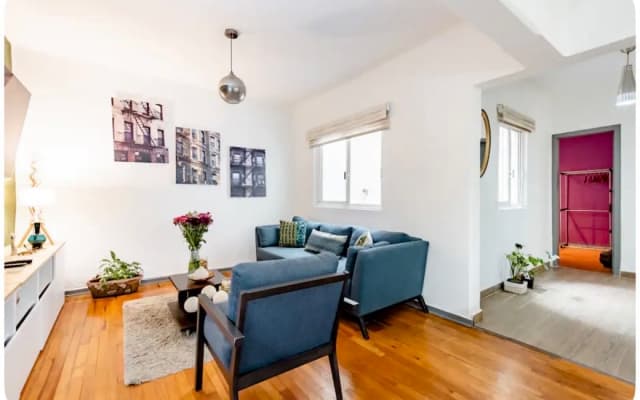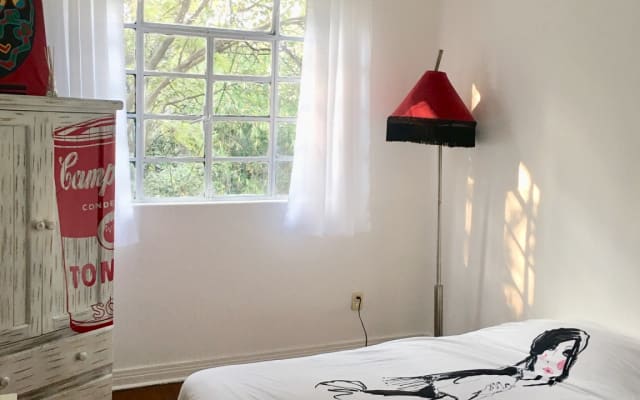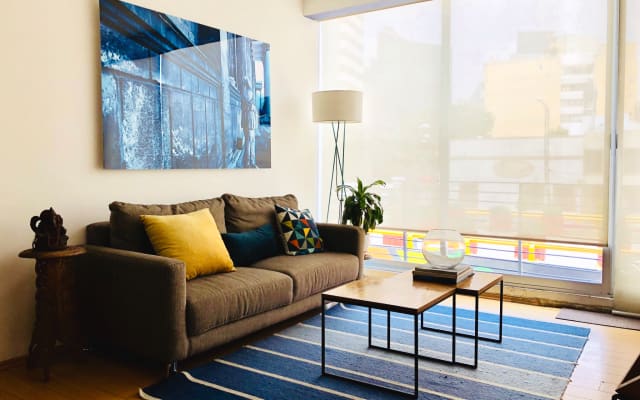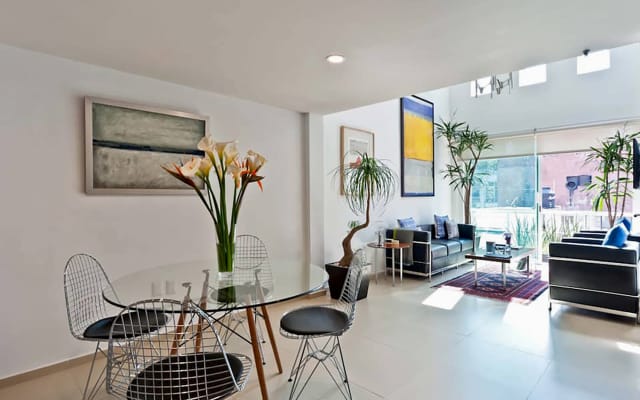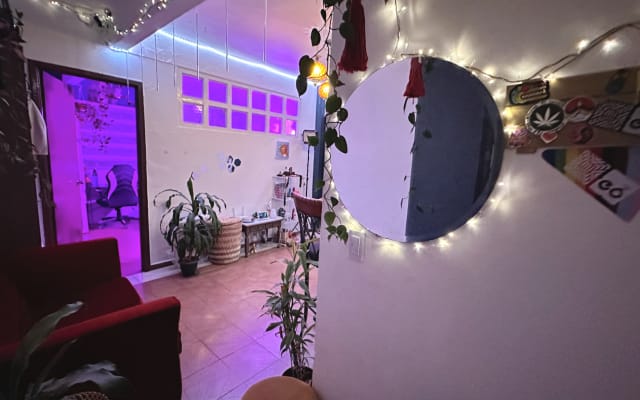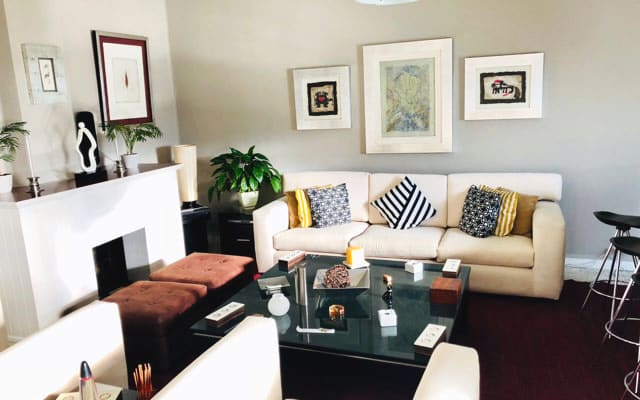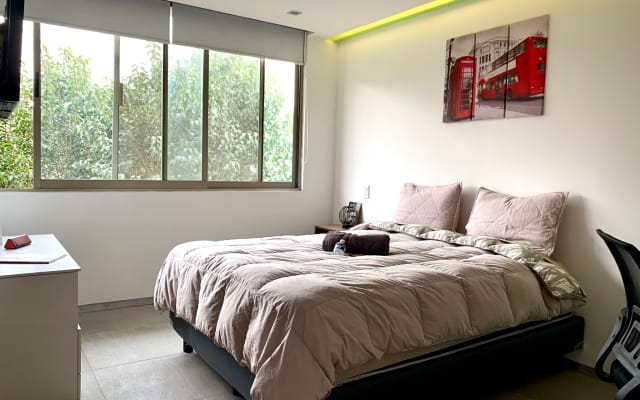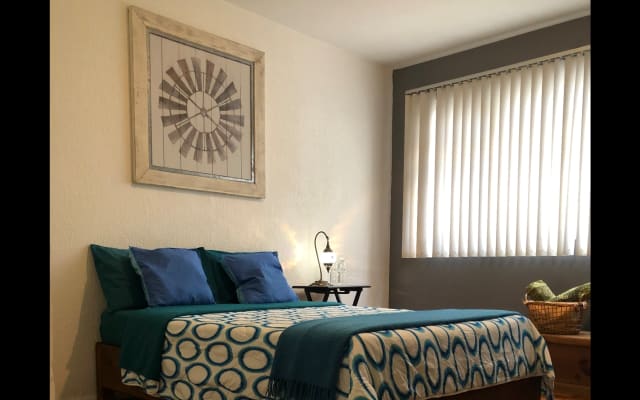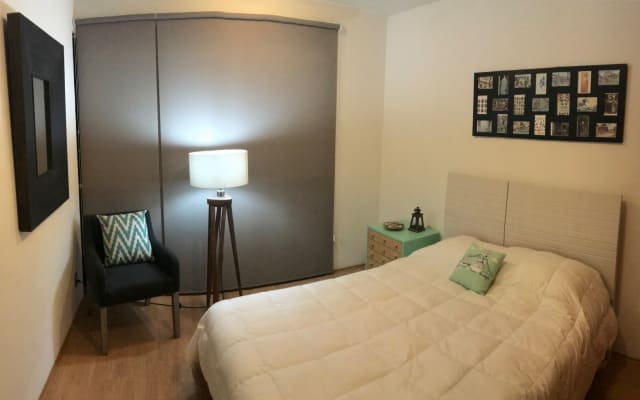-
Private room
-
1 guest
-
1 bedroom
-
1 bathroom
-
1 bed
- Host shares gay local tips
- LGBTQ+ venues nearby
- Wi-Fi
- Gym
Why book with misterb&b?
About the Place Initially in English, this text was translated via a machine translation service and may contain inaccuracies or errors.
It is a private room inside my apartment, the location is central.
Very close to the #Metro, #ecobici and #Trolleybus communicate it.
The apartment is safe.
There are nearby convenience stores, ATM's and banks,
Pharmacy and an express supermarket one block away.
"The Obrera neighborhood is located in the Cuauhtémoc district of Mexico City and covers an area of about 160 hectares.
The Obrera neighborhood is one of the most representative popular neighborhoods of the CDMX. In its beginnings, Colonia Obrera was the land of El Cuartelito, a pasture that Santa Anna's troops occupied in the mid-1800s. It received its official name at the end of the 1920s, due to the fact that most of its inhabitants were engaged in some trade.
The Obrera neighborhood was distinguished for many years for having numerous cabarets, nightclubs, cantinas, pulquerias and breweries, considered places of bad reputation, but also centers of entertainment and amusement.
The first houses of the colony formed neighborhoods. In the so-called "jacales" (shacks) area, there were wooden and tin shacks that, over time, mainly as a result of the 1985 earthquake, disappeared to make way for condominiums or apartments.
The main activity developed in Obrera is Industry, in which about 1,000 establishments operate, with an estimated 10,000 people employed.
Obrera is home to about 33,400 people in 11,000 housing units, making it one of the most populated neighborhoods in Mexico City. There are 2,105 inhabitants per square kilometer, with an average age of 36 years and an average of 11 years of schooling.
Of the 40,000 people living in Obrera, 7,000 are under 14 years of age and 8,000 are between 15 and 29 years of age. When the higher age ranges are analyzed, there are 20,000 people between the ages of 30 and 59, and 5,200 individuals over the age of 60.
Obrera has an estimated economic output of MXN $12,000 million annually, of which MXN $2,200 million corresponds to income generated by households and some MXN $9,000 million to income from the 2,800 establishments that operate there.
In addition, an estimated 20,000 people work in the neighborhood, bringing the total number of residents and workers to 50,000.
Nearby Metro Station: San Antonio Abad: San Antonio Abad is a Mexico City Metro station located on Line 2, also known as the Blue Line. This line connects the stations of Cuatro Caminos, in the north of the city, with Tasqueña, in the south. San Antonio Abad station is located in the Obrera neighborhood, in the Cuauhtémoc district.
Although the station itself has no tourist attractions, its strategic location makes it an important connection point for residents and visitors to the area. From here, it is possible to access various areas of the city, as well as other means of transportation to travel to different points of ******** addition, this Line connects with key stations such as Pino Suarez, Hidalgo and Tacuba, allowing access to emblematic places such as the Zocalo, the Palace of Fine Arts and Chapultepec Forest, among others."
It is a private room inside my apartment, the location is central.
Very close to the #Metro, #ecobici and #Trolleybus communicate it.
The apartment is safe.
There are nearby convenience stores, ATM's and banks,
Pharmacy and an express supermarket one block away.
"The Obrera neighborhood is located in the Cuauhtémoc district of Mexico City and covers an area of about 160 hectares.
The Obrera neighborhood is one of the most representative popular neighborhoods of the CDMX. In its beginnings, Colonia Obrera was the land of El Cuartelito, a pasture that Santa Anna's troops occupied in the mid-1800s. It received its official name at the end of the 1920s, due to the fact that most of its inhabitants were engaged in some trade.
The Obrera neighborhood was distinguished for many years for having numerous cabarets, nightclubs, cantinas, pulquerias and breweries, considered places of bad reputation, but also centers of entertainment and amusement.
The first houses of the colony formed neighborhoods. In the so-called "jacales" (shacks) area, there were wooden and tin shacks that, over time, mainly as a result of the 1985 earthquake, disappeared to make way for condominiums or apartments.
The main activity developed in Obrera is Industry, in which about 1,000 establishments operate, with an estimated 10,000 people employed.
Obrera is home to about 33,400 people in 11,000 housing units, making it one of the most populated neighborhoods in Mexico City. There are 2,105 inhabitants per square kilometer, with an average age of 36 years and an average of 11 years of schooling.
Of the 40,000 people living in Obrera, 7,000 are under 14 years of age and 8,000 are between 15 and 29 years of age. When the higher age ranges are analyzed, there are 20,000 people between the ages of 30 and 59, and 5,200 individuals over the age of 60.
Obrera has an estimated economic output of MXN $12,000 million annually, of which MXN $2,200 million corresponds to income generated by households and some MXN $9,000 million to income from the 2,800 establishments that operate there.
In addition, an estimated 20,000 people work in the neighborhood, bringing the total number of residents and workers to 50,000.
Nearby Metro Station: San Antonio Abad: San Antonio Abad is a Mexico City Metro station located on Line 2, also known as the Blue Line. This line connects the stations of Cuatro Caminos, in the north of the city, with Tasqueña, in the south. San Antonio Abad station is located in the Obrera neighborhood, in the Cuauhtémoc district.
Although the station itself has no tourist attractions, its strategic location makes it an important connection point for residents and visitors to the area. From here, it is possible to access various areas of the city, as well as other means of transportation to travel to different points of ******** addition, this Line connects with key stations such as Pino Suarez, Hidalgo and Tacuba, allowing access to emblematic places such as the Zocalo, the Palace of Fine Arts and Chapultepec Forest, among others."
Amenities
- Host shares gay local tips
- LGBTQ+ venues nearby
- Wi-Fi
- Kitchen
- TV
- Essentials
- Washer
- Gym
- Adult Only
Be the first to review this property!
The hosts took the time to best showcase their accommodation. Their home is now ready for your stay and they look forward to welcoming you as their first misterb&b guest!About the Host
Property Rules Initially in English, this text was translated via a machine translation service and may contain inaccuracies or errors.
Conditions
Cancellation Policy


You can contact Ritchie through the Contact Host button on this page. If you've already booked, go to My trips.
Travel with peace of mind while connecting with the gay community. As the largest gay hotelier in the world, misterb&b guarantees secure payments, Booking insurance Coverage, and a customer support team that is at your service.
It is up to the host to ask for a security deposit. If there is a security deposit on the listing, the amount is displayed underneath the price per night.
A confirmation e-mail with the contact information of your host will be sent to your e-mail address upon a successful booking. Log in to your misterb&b account and visit My trips. Here you will find the status and details of all your bookings and booking requests.
More about gay Mexico City





